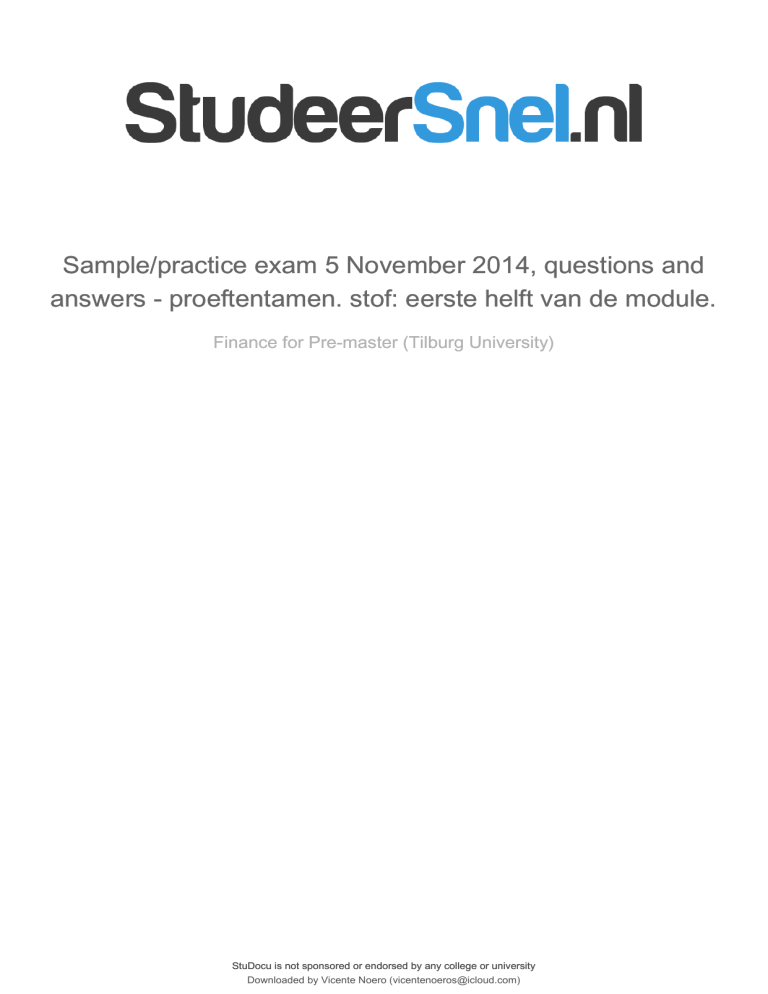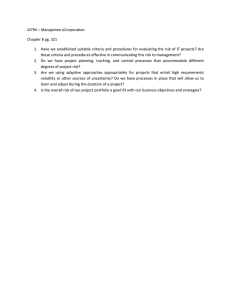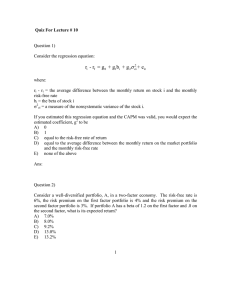
lOMoARcPSD|9112190 Sample/practice exam 5 November 2014, questions and answers - proeftentamen. stof: eerste helft van de module. Finance for Pre-master (Tilburg University) StuDocu is not sponsored or endorsed by any college or university Downloaded by Vicente Noero (vicentenoeros@icloud.com) lOMoARcPSD|9112190 Name: ANR: GROUP A Exercise 1 Foxconn is considering the development of a new smart phone manufacturing line that assembles devices completely automatically. The development would take 5 years costing $200,000 every year. From year 6 Foxconn expects that the new production system would generate $350,000 net income a year for 8 years and that profits would grow at a rate of 3%. After that point competition enters the market abolishing Foxconn's profits. Foxconn is all-equity financed. Foxconn’s equity beta is 1.2, the risk-free rate is 2 percent and the market risk premium is 10%. Suppose that the CAPM holds. 1. What is Foxconn’s risk premium? 1. 10% 2. 12% 3. 14% 4. 16% 2. What is the present value of the cost of development? (In absolute value) 1. $683,000-689,000 2. $717,000-723,000 3. $755,000-761,000 4. $651,000-657,000 3. What is the present value of profits? 1. $783,000-789,000 2. $1,074,000-1,080,000 3. $915,000-921,000 4. $1,266,000-1,272,000 4. The IRR of the project is 19.52%. Would it be profitable for Foxconn to undertake the project if its risk premium was 19%? 1. Yes 2. No 3. The risk premium does not matter 4. Not enough information Exercise 2 There are two stocks, x and y. The expected return of x is 12% with 20% volatility. The expected return of y is 25% with 37% volatility. The correlation between x and y is 0.2. The risk-free rate is 3%. You form a portfolio by going long $10,000 in x and short $2,000 in y. Your net position in the portfolio is 1. $8,000 2. $12,000 3. $10,000 4. -$2.000 The expected return on the portfolio is 1. 0.15-0.16 2. 0.17-0.18 3. 0.08-0.09 4. 0.18-0.19 The volatility of the portfolio is 1. 0.11-0.12 2. 0.24-0.25 3. 0.06-0.07 4. 0.26-0.27 Continued on next page Downloaded by Vicente Noero (vicentenoeros@icloud.com) lOMoARcPSD|9112190 Suppose that the correlation increases to 0.5. What happens to the expected return? 1. Increases 2. Decreases 3. Stays the same 4. Cannot be determined Exercise 3 A good approximation of real interest rates is… 1. The difference between nominal interest rates and inflation 2. The difference between inflation and nominal interest rates 3. The sum on nominal interest rates and inflation 4. All of the above 5. None of the above Heineken NV currently trades at €50 on AEX and as Heineken ADR on NYSE at $65. The current $/€ exchange rate is $1.25/€. Could you make an arbitrage profit in this situation? 1. Yes, sell Heineken NV, buy ADR 2. Yes, buy Heineken NV, sell ADR 3. No, the law of one price holds 4. Not enough information In a perfect capital market… 1. Arbitrage opportunities (if any) immediately disappear 2. Prices reflect all information 3. The law of one price holds 4. All of the above 5. None of the above A portfolio is efficient… 1. If it has the highest Sharpe-ratio 2. If it has the best risk-return trade-off 3. If it has the same loadings as the market portfolio 4. All of the above 5. None of the above The risk premium… 1. Cannot be negative 2. Is always higher than the risk-free rate 3. Is equal to the return on the market index 4. All of the above 5. None of the above Assume that the CAPM holds. The risk premium of a zero-beta stock… 1. Cannot be determined 2. Is certainly higher than the risk-free rate 3. Is equal to the market risk premium 4. Is zero Combining a hundred perfectly correlated stocks into a portfolio… 1. Is good because the more stocks you hold the lower your portfolio volatility is 2. Increases your expected return 3. Does not have any diversification benefits 4. Increases the volatility of the portfolio Downloaded by Vicente Noero (vicentenoeros@icloud.com)



